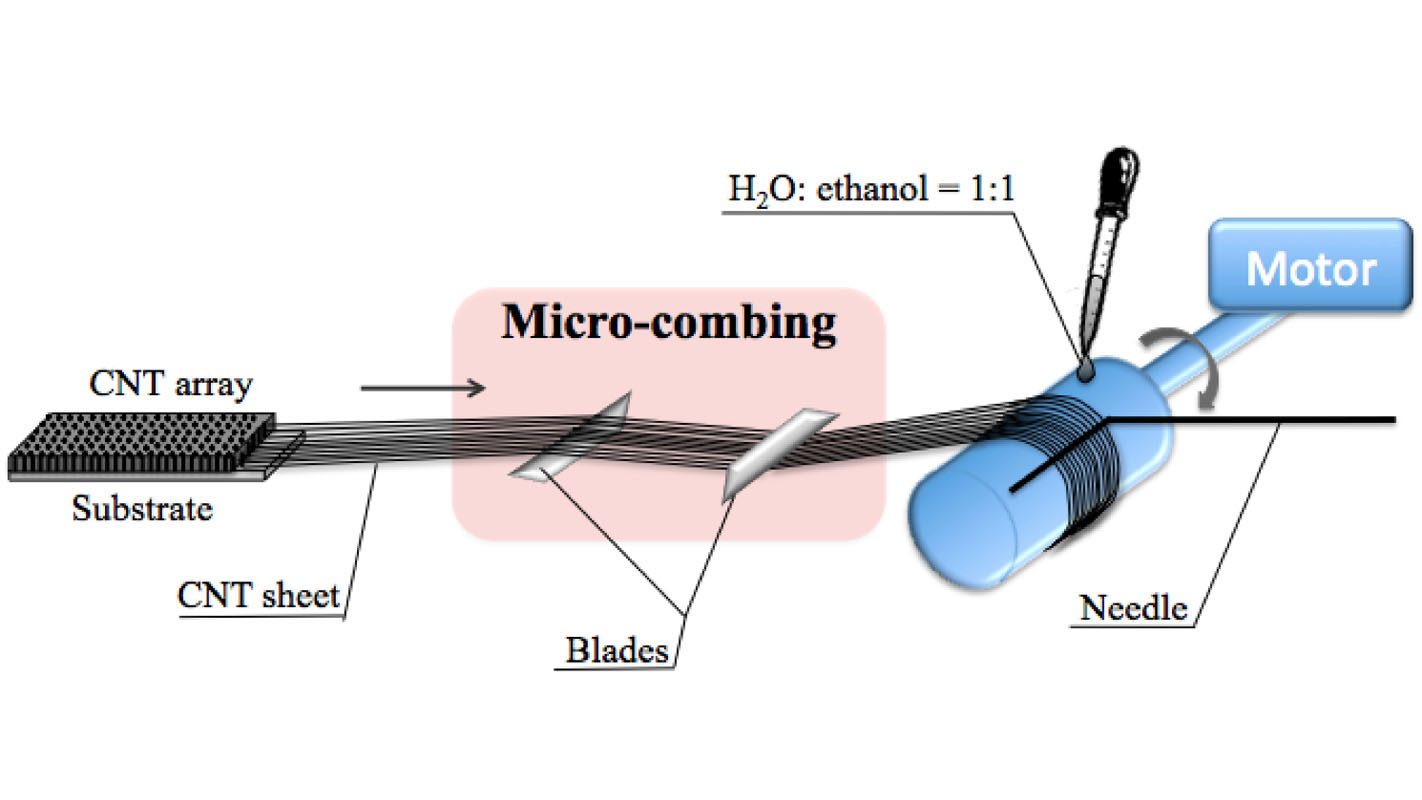‘Microcombing’ Creates Stronger, More Conductive Carbon Nanotube Films

For Immediate Release
Researchers from North Carolina State University and China’s Suzhou Institute of Nano-Science and Nano-Biotics have developed an inexpensive technique called “microcombing” to align carbon nanotubes (CNTs), which can be used to create large, pure CNT films that are stronger than any previous such films. The technique also improves the electrical conductivity that makes these films attractive for use in electronic and aerospace applications.
“It’s a simple process and can create a lightweight CNT film, or ‘bucky paper,’ that is a meter wide and twice as strong as previous such films – it’s even stronger than CNT fibers,” says Yuntian Zhu, Distinguished Professor of Materials Science and Engineering at NC State and corresponding author of a paper describing the work.

The researchers begin by growing the CNTs on a conventional substrate in a closely packed array. The CNTs are tangled together, so when researchers pull on one end of the array the CNTs form a continuous ribbon that is only nanometers thick. This ribbon is attached to a spool, which begins winding the ribbon up.
As the spool pulls, the CNT ribbon is dragged between two surgical blades. While the blades appear straight to the naked eye, they actually have micrometer-scale fissures on their cutting edge. These fissures create a kind of “microcomb” that pulls the CNTs into alignment – just as a regular comb sorts through tangled hair.
When the ribbon of aligned CNTs is being wound onto the spool, the researchers apply an alcohol solution. This pulls the CNTs closer together, strengthening the bonds between CNTs.
The CNT ribbon wraps around itself as it winds around the spool, creating a layered film of pure CNTs. Researchers can control the thickness of the film by controlling the number of layers.
The CNT films made using the microcombing technique had more than twice the tensile strength of the uncombed CNT films – greater than 3 gigapascals for the microcombed material, versus less than 1.5 gigapascals for the uncombed material.
The microcombed CNT film also had 80 percent higher electrical conductivity than the uncombed film.
“This is a significant advance, but we want to find ways to make CNT alignment even straighter,” Zhu says. “It’s still not perfect.
“In addition, the technique would theoretically be easy to scale up for large-scale production. We’d like to find an industry partner to help us scale this up and create a material for the marketplace.”
The paper, “Strong and Conductive Dry CNT Films by Microcombing,” is published online in the journal Small. Lead author of the paper is NC State Ph.D. student Liwen Zhang. Co-authors include Xin Wang, Weizong Xu and Philip Bradford of NC State; and Yongyi Zhang and Qingwen Li of the Suzhou Institute. The work was supported by the Air Force Office of Scientific Research under grant number FA9550–12–1–0088.
-shipman-
Note to Editors: The study abstract follows.
“Strong and Conductive Dry CNT Films by Microcombing”
Authors: Liwen Zhang, Xin Wang, Weizong Xu, Philip D. Bradford, and Yuntian Zhu, North Carolina State University; Yongyi Zhang and Qingwen Li, Suzhou Institute of Nano-Science and Nano-Biotics
Published: online May 4, Small
DOI: 10.1002/smll.201500111
Abstract: In order to maximize the carbon nanotube (CNT) buckypaper properties, it is critical to improve their alignment and reduce their waviness. In this paper, a novel approach is reported;microcombing, to fabricate aligned CNT filmswith a uniformstructure. High level of nanotube alignment and straightness was achieved using sharp surgical blades with microsized features at the blade edges to comb single layer of CNT sheet. These microcombs also reduced structural defectswithin the filmand enhanced the nanotube packing density. Following themicrocombing approach, the as-produced CNT films demonstrated a tensile strength of up to 3.2 GPa, Young’s modulus of up to 172 GPa, and electrical conductivity of up to 1.8 × 105 S m-1, which are much superior to previously reported CNT films or buckypapers. More importantly, this novel technique requires less rigorous process control and can construct CNT films with reproducible properties.
- Categories:


